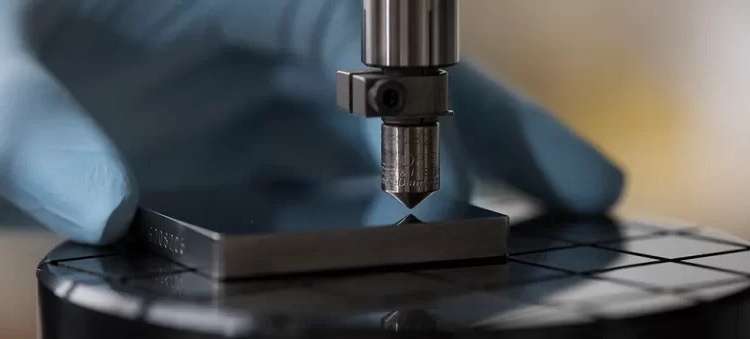Stainless steel materials are widely used in various industries. Different stainless steel materials have different hardness. How do we test the hardness of stainless steel?

What Is The Hardness Of Stainless Steel?
Hardness is one of the indicators for evaluating material properties and is usually defined as the material's ability to resist local plastic deformation. This ability is reflected in whether the material will be permanently deformed or damaged when subjected to external pressure, scratches or wear. The harder the material, the greater its resistance to deformation, which means it is less likely to deform.
After the steel mill produces steel, some standard hardness test methods are used to determine its hardness value, which usually helps to determine its tensile strength. The hardness value of stainless steel will determine whether it is suitable for the intended design or use.
What Factors Can Affect The Hardness Of Stainless Steel?
There are many influencing factors, and common factors include chemical composition, microstructure, heat treatment method, etc.
 Chemical composition:
Chemical composition:
- Chromium: Enhances corrosion resistance and helps to increase hardness.
- Nickel: Improves ductility and toughness, which can reduce hardness.
- Carbon: The higher the carbon content, the higher the hardness, especially for martensitic grades.
- Molybdenum: Improves corrosion resistance and can increase the hardness of some alloys.
 Microstructure:
Microstructure:
- Austenite structure: Usually soft due to its face-centered cubic structure.
- Ferrite structure: Provides medium hardness and strength.
- Martensite structure: High hardness is achieved through transformation processes during quenching.
 Heat treatment:
Heat treatment:
- Quenching: Rapid cooling from high temperature increases hardness, especially in martensitic stainless steels.
- Tempering: Heating quenched steel to a lower temperature reduces brittleness while retaining some hardness.
What Are The Methods For Testing The Hardness Of Stainless Steel?
Several different scales are commonly used for hardness testing of stainless steel, the most common of which include Brinell hardness (HB), Rockwell hardness (HR) and Vickers hardness (HV).
1. Brinell hardness (HB)
 Test method: The Brinell hardness test is to press a hardened steel ball or carbide ball into the surface of the stainless steel under a specified load. The diameter of the indentation is measured and the Brinell hardness value is calculated.
Test method: The Brinell hardness test is to press a hardened steel ball or carbide ball into the surface of the stainless steel under a specified load. The diameter of the indentation is measured and the Brinell hardness value is calculated.
 Unit: Expressed in HB (Brinell hardness value), with larger values indicating higher hardness.
Unit: Expressed in HB (Brinell hardness value), with larger values indicating higher hardness.
 Applicable materials: Applicable to softer metals and alloys, usually used for materials such as cast iron, copper and aluminum.
Applicable materials: Applicable to softer metals and alloys, usually used for materials such as cast iron, copper and aluminum.
2. Rockwell hardness (HR)
 Test method: Use a small conical drill bit (usually diamond) or a steel ball to press into the material under a specific load, and measure the depth difference between the material under load and after unloading.
Test method: Use a small conical drill bit (usually diamond) or a steel ball to press into the material under a specific load, and measure the depth difference between the material under load and after unloading.
 Unit: Expressed in HR, there are multiple scales (such as HRA, HRB, HRC, etc.), among which HRC is the most commonly used scale, suitable for materials with higher hardness (such as stainless steel).
Unit: Expressed in HR, there are multiple scales (such as HRA, HRB, HRC, etc.), among which HRC is the most commonly used scale, suitable for materials with higher hardness (such as stainless steel).
 Applicable materials: Suitable for materials with higher hardness, can be tested quickly, and widely used in hardness testing of metal materials.
Applicable materials: Suitable for materials with higher hardness, can be tested quickly, and widely used in hardness testing of metal materials.
3. Vickers hardness (HV)
 Test method: The Vickers hardness test uses a diamond pyramid indenter to press out an indentation, measure the diagonal of the indentation under a microscope, and calculate the hardness value.
Test method: The Vickers hardness test uses a diamond pyramid indenter to press out an indentation, measure the diagonal of the indentation under a microscope, and calculate the hardness value.
 Unit: Expressed in HV, the larger the value, the higher the hardness.
Unit: Expressed in HV, the larger the value, the higher the hardness.
 Applicable materials: Applicable to all metal materials, especially in the measurement of thin plates, tiny samples and surface hardness.
Applicable materials: Applicable to all metal materials, especially in the measurement of thin plates, tiny samples and surface hardness.
Conclusion:
The hardness of stainless steel is one of its important physical properties, which directly affects its application range and processing performance. By understanding the hardness of stainless steel and its influencing factors, we can better select the appropriate stainless steel material to meet specific engineering needs.
